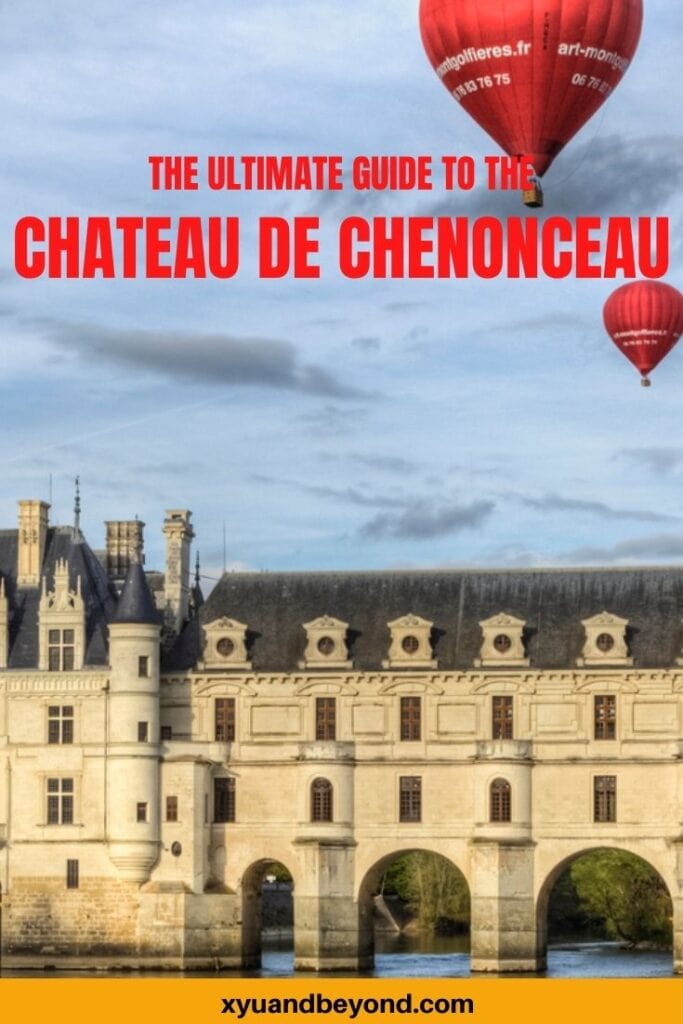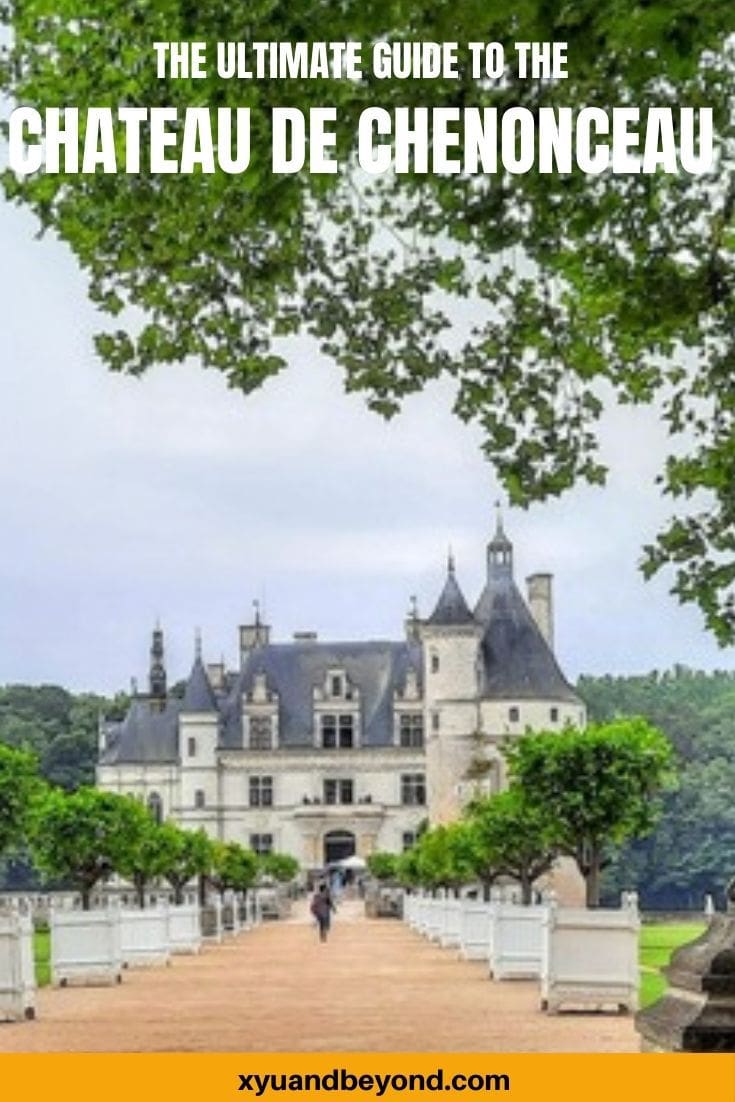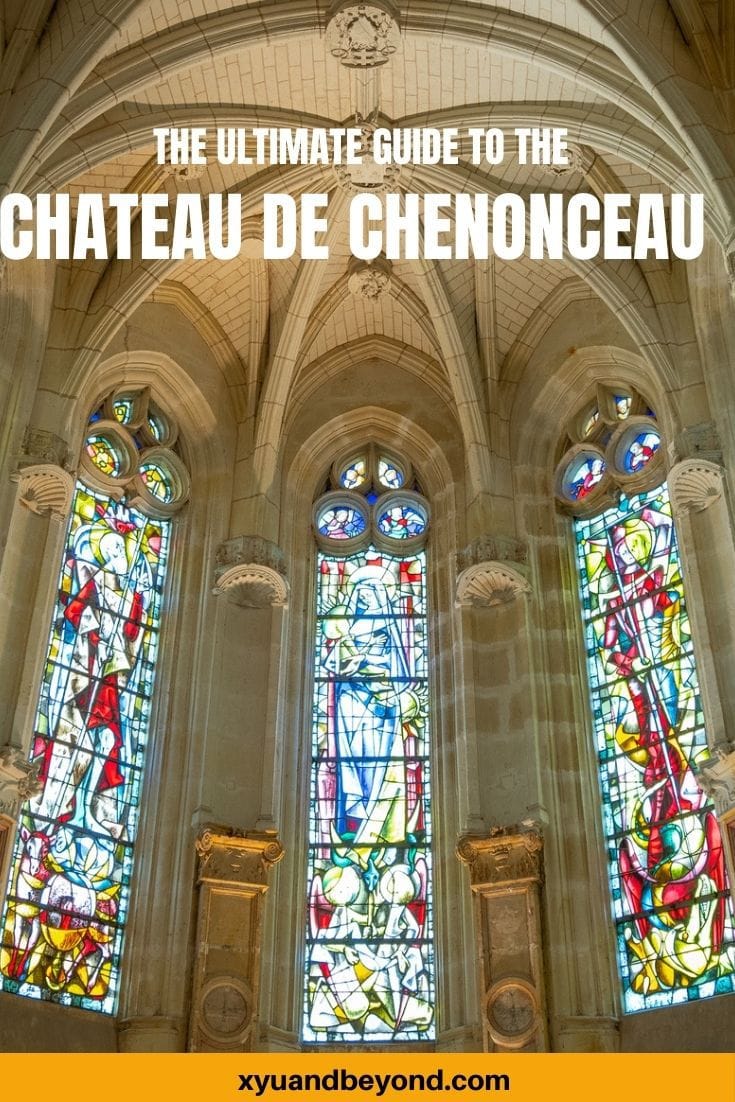Visiting the magnificent Chateau de Chenonceau: Loire Valley
The most famous chateau in France has to be the Chateau Chenonceau and has been a must-visit for me ever since I saw photographs of this stunningly beautiful fairytale castle. The former hunting grounds of the French King’s Chenonceau Château spanning the River Cher in the Loire Valley and is nicknamed “Château des Dames”.
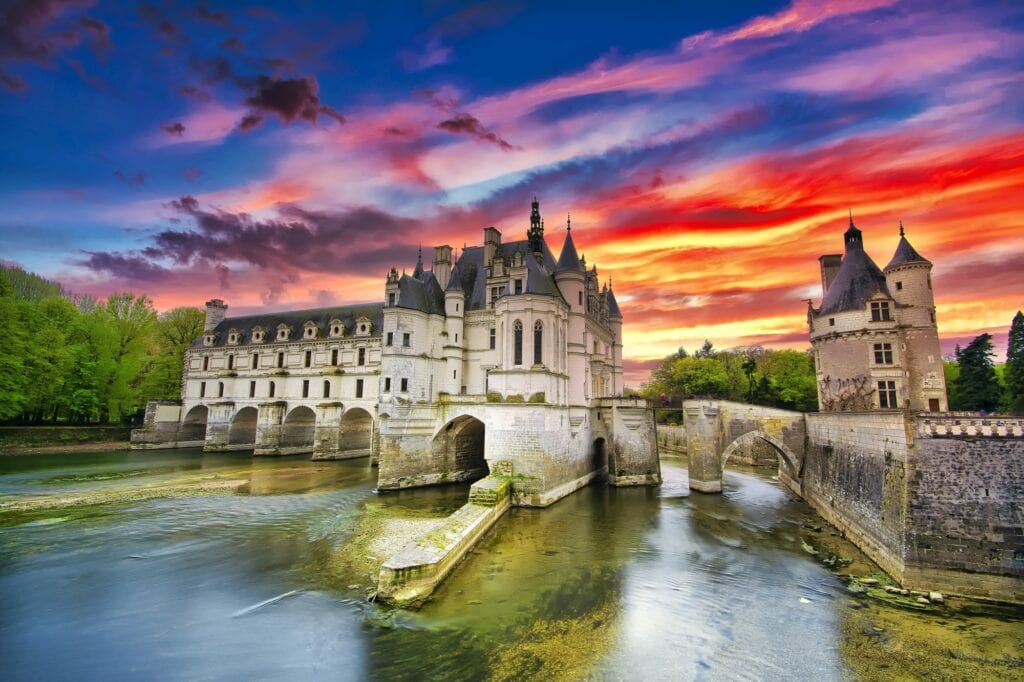
The castles or châteaux of the Loire Valley are one of Frances’s major attractions and the area of the Loire has more than 300 castles in the 175 miles stretch along the Loire River. The château Chenonceau has been part of the UNESCO World Heritage since 2017. The Loire River was once immensely important. It has long been a way for Celts, Greeks, Romans and others to trade up and down its length. When France became a nation the Loire Valley was the dividing point between the north and south of the country. During the Hundred Years War, the Loire Valley was a battleground between the French and the English.
We took a leisurely drive down to the Val de Loire (Loire Valley) from Lassay in the Mayenne which took around 3 hours. We planned to stay in Amboise which is the perfect centre point for visiting many chateaux, not to mention enjoying some fine French cuisine and fabulous Loire Valley wines.
When the Hundred Years’ War ended in 1453, these castles or chateaux were turned from defensive forts to Palaces. At this time Tours was the capital of France and Louis XI made his Touraine Chateau his permanent residence. The court followers of course decided to copy the King and they bought up ruined castles and restored them to be suitable princely residences.
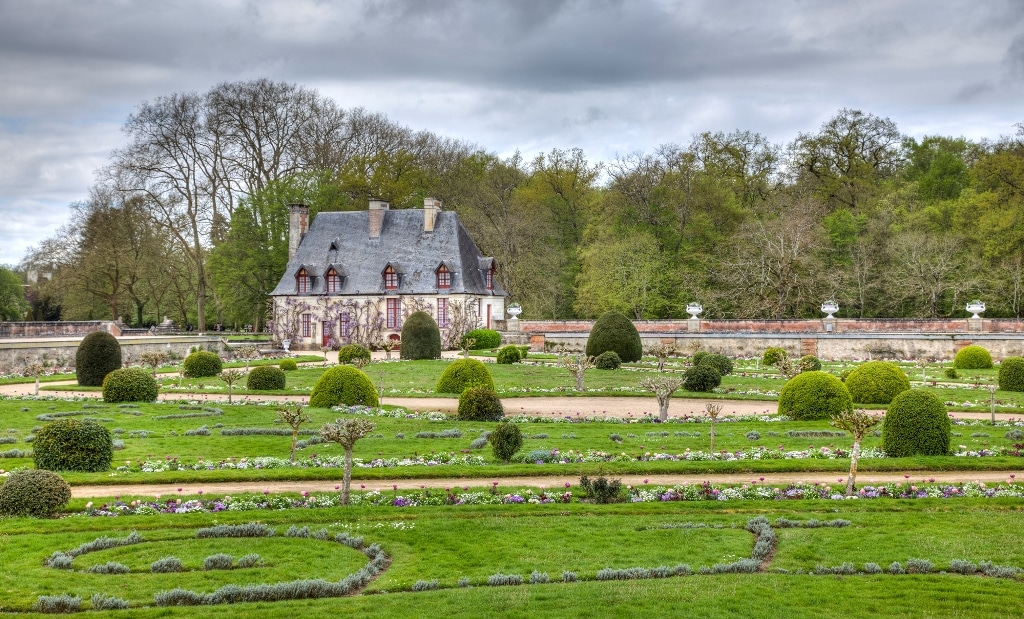
Some castles were built from the ground up like Chateau de Chambord these castles brought wealth not only in money but in the art of the Renaissance period and Leonardo da Vinci came to live in the Loire. Eventually, the French nobility and their courts moved to Paris where their residences became Fontainebleau and Versailles but kept their castles in the Loire – sort of like a vacation home.
Around 100 or so of the Loire chateaux are now open to the public, while others are established as luxury hotels, and many are still in private ownership.
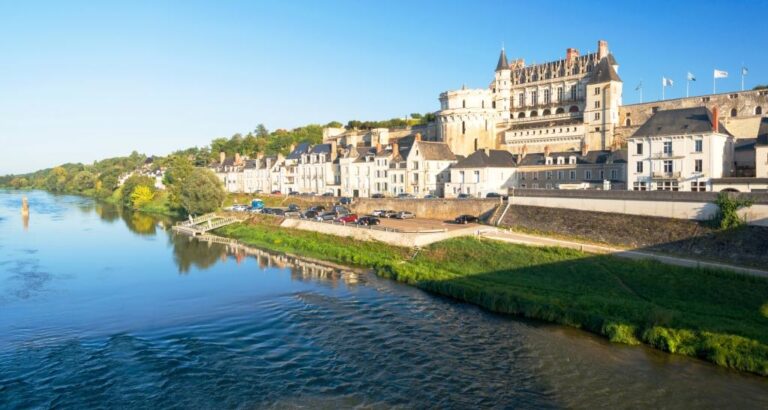
- Visiting the magnificent Chateau de Chenonceau: Loire Valley
- Where is the Chateau de Chenonceau located?
- Chenonceau tickets
- Ghosts at the Chateau of Chenonceau
- Best Times to Visit Château Chenonceau
- Chateau de Chenonceau parking
- History of the Chateau de Chenonceau
- History of Chateau Chenonceau: Château des Dames
- Diane de Poitiers Castle
- Catherine de Medici at Château de Chenonceau
- Louise de Lorraine – Henri III's wife
- Louise Dupin
- Marguerite Pelouze
- Chateau Chenonceau 20th century
- What to see at the Chateau Chenonceau
- Chateau de Chenonceau inside
- Gardens of the Chateau de Chenonceau
- WWI and WWII at Chenonceau
- Where to eat at Chenonceau
- Where to stay near Chenonceau
- FAQS about the Chateau de Chenonceau
- Frequently Asked Questions about the Château de Chenonceau
- 1. What is the Château de Chenonceau?
- 2. Who were Catherine de Medici and Diane de Poitiers in relation to the Château de Chenonceau?
- 3. What makes the Château de Chenonceau unique?
- 4. Is the Château de Chenonceau open to the public?
- 5. When was the Château de Chenonceau built?
- 6. What role did the Château de Chenonceau play in history?
Xyuandbeyond is reader-supported. When you buy through links on our site, we may earn an affiliate commission. You can read my privacy policy here.
Where is the Chateau de Chenonceau located?
Built on the banks of the River Cher, the Château de Chenonceau is located near the small village of Chenonceaux in the Loire Valley in the Central Val de Loire region. The Château de Chenonceau can be reached by public transportation with trains arriving from Tours and Bourges. The TER train station at Chenonceau is almost next to the Château de Chenonceau entrance. TER trains are the Transport Express Régional trains found in most parts of France these are not the super-fast TGV trains.
Paris to Chenonceau
The Château de Chenonceau is easily accessible by car via the A10 motorway (Blois or Amboise exit). By train from Paris, first take the TGV for 1 hour between Gare Montparnasse and Tours (Saint-Pierre-des-Corps station) then the TER for 25 minutes between Tours and Chenonceau.
We drove to the Château de Chenonceau and decided on staying in Amboise which is around 15 minutes from most of the major Chateaus in the area. For us, it was a 2-hour trip from Lower Normandy and from Paris, it is about a 3-hour drive.
TIP
If you decide to drive to Chenonceau you can use Google maps to take the journey, but beware if you choose the toll roads which do get you there quicker you will be paying a minimum of €12.90 for the first toll and then another €5.90 for the second part of the journey. That’s just on the way there. You can take non-toll roads just set your maps to choose no tolls but know that it will take around an hour more.
How to see the Chateau Chenonceau
As I mentioned we drove to the Loire Valley and journeyed to Chenonceau Chateau from Amboise which took around 15 minutes or so.
Chenonceau tickets
I purchased skip-the-line tickets from Get Your Guide – which by the way are the same price as you would pay at the Chateau ticket offices. Tickets with guide leaflet €15.50 and with audioguide €19.50.
The parking is free at the castle of Chenonceau (unlike Chambord) and while it was a bit of a walk to the Chateau itself the walk is simply stunning.
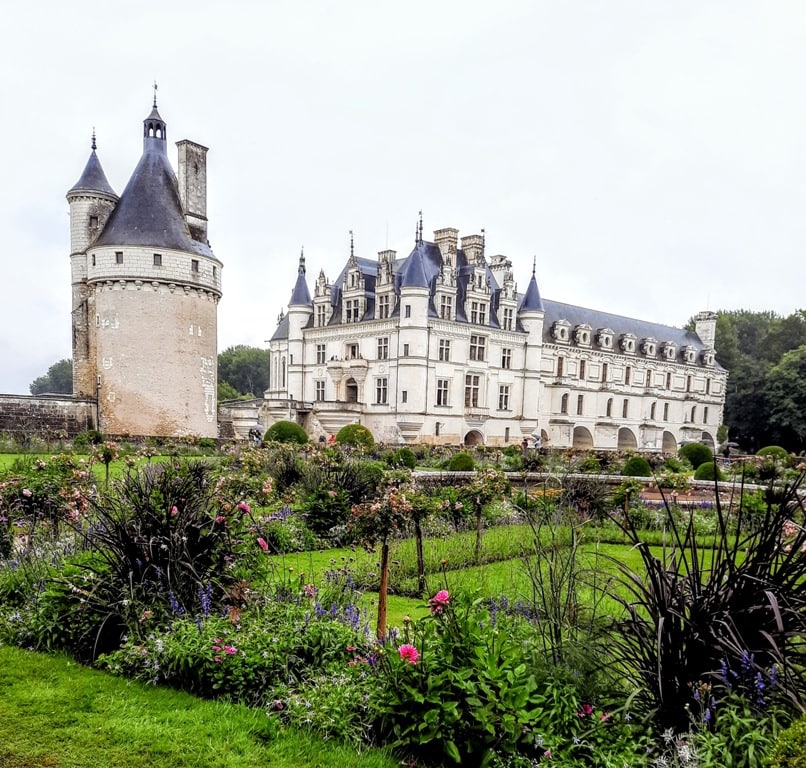
The Chateau Chenonceau is perhaps the most visited of all in this area and dates back to 1513. An exquisite castle it is the most important and most visited of the French castles, second only to the Palace of Versailles. A truly magical castle, Chenonceau spans the River Cher and like most French chateaux is surrounded by incredible gardens and forests. It is one of the best-known châteaux of the Loire Valley, and the second most visited castle in France after Versailles.
The walk is breathtaking, surrounded by tall trees that bathe you in a green light you know you are walking in the footsteps of all the women that made Chenonceau castle great.
As you exit the path of trees you will immediately see this stunningly beautiful castle in the distance with its stone lions to greet you it takes your breath away. This is why you came to visit France, this legacy of great chateaux and in particular the legacy of some of France’s legendary women.
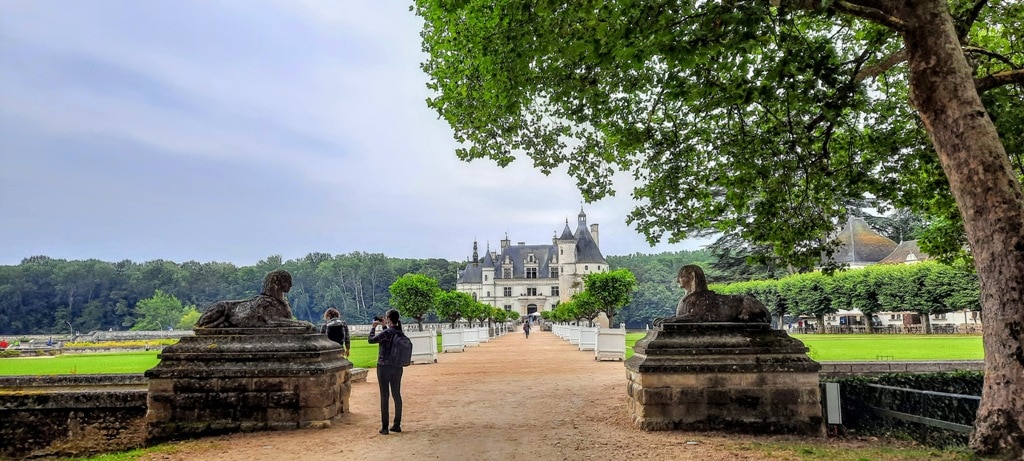
Ghosts at the Chateau of Chenonceau
A glorious Chateau like Chenonceau has to be haunted right? Well, the villagers do tell tales of the White Queen walking the gallery in mourning for her lost love. There are legends that say Diane de Poitiers can be seen occasionally gazing into a mirror in her old bedroom and stories of Catherine de Medici wandering in the light of the full moon, combing her hair.
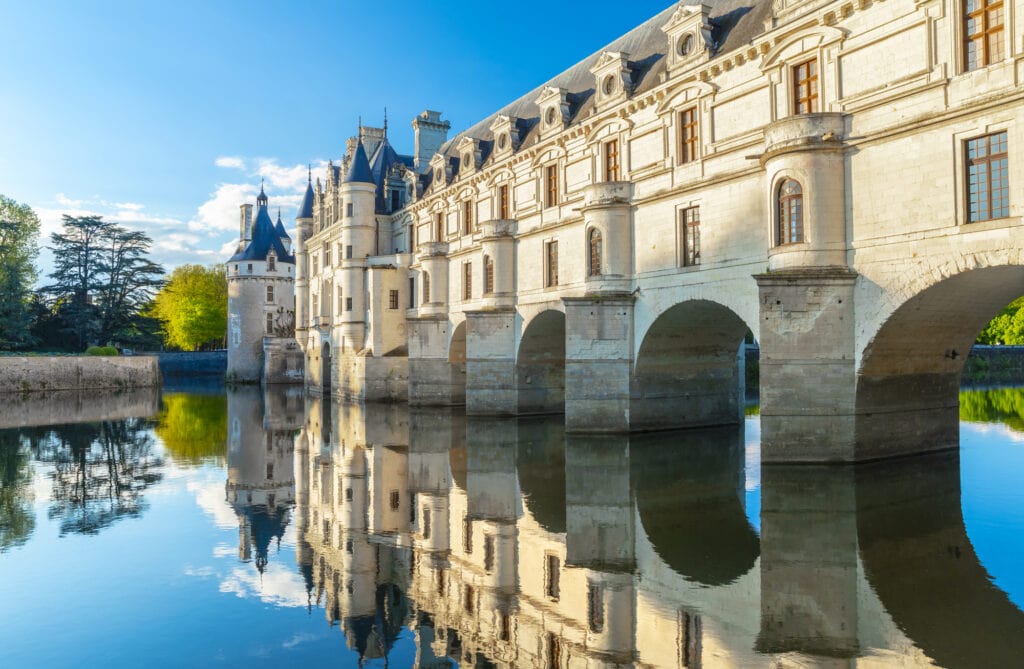
Best Times to Visit Château Chenonceau
Château de Chenonceau is a relatively small castle when compared to say Versailles but it still gets very crowded in the high season here in France which is July and August. I would recommend in a normal year visiting outside those months and avoiding school holidays, weekends and in particular long weekends. However, if those times cannot be avoided go first thing in the morning when the Chateau opens at 9 am.
Chateau de Chenonceau parking
There is plenty of parking for cars, coaches and campers at Chenonceau and even chargers for electric vehicles. The cost of parking is included in the ticket price.
Tips for visiting Château de Chenonceau in July and August
Visit during lunchtime – tour groups usually do not visit between around noon and 1 pm, but families may.
Visit late afternoon – I would suggest around 5 pm as the Chateau is open until 7. Day tours are less common during these hours and it is a fantastic time to photograph the gardens.
The cost of visiting Château de Chenonceau is 15.00 € per adult which includes a brochure, there is an audio guide available but sadly not in use in 2021.
History of the Chateau de Chenonceau
The Château de Chenonceau or as it is also known the Chateau des Dames or ‘ladies chateau’ due to the substantial influence powerful women had on its development – is the second most-visited chateau in France and in my eyes probably the most romantic.
A little bit of French history
You may have noticed the x on the end of Chateaux in some cases has been dropped this was because, during the French Revolution, the x was dropped to show that the castle in question was not owned by Royalty.
History of Chateau Chenonceau: Château des Dames
A grand Maison was built at Chenonceau in the 13th Century by Jean Marques but this building was apparently set on fire thanks to the sedition of its owner. The ruins of this mansion were sold in 1500 to pay the debts of the owners. It was purchased by Thomas Bohier and his wife Katherine Briçonnet and it was Katherine who designed the Chateau in the Renaissance style.
Diane de Poitiers Castle
In the 16th Century, King Henry II gave the Chateau to Diane de Poitiers, his mistress. This of course caused no end of grief to his wife Catherine de Medici who was furious at this slight. Diane fell in love with Chenonceau and spent huge sums of money turning Chenonceau into a Palace to rival Versailles.
In 1556 Diane commissioned a bridge to be built over the Cher and Philibert de l’Orme and designed a 5 arch bridge to link the chateau and the long gallery to the gardens. Diane also designed a French formal-style garden that covered 3 acres.
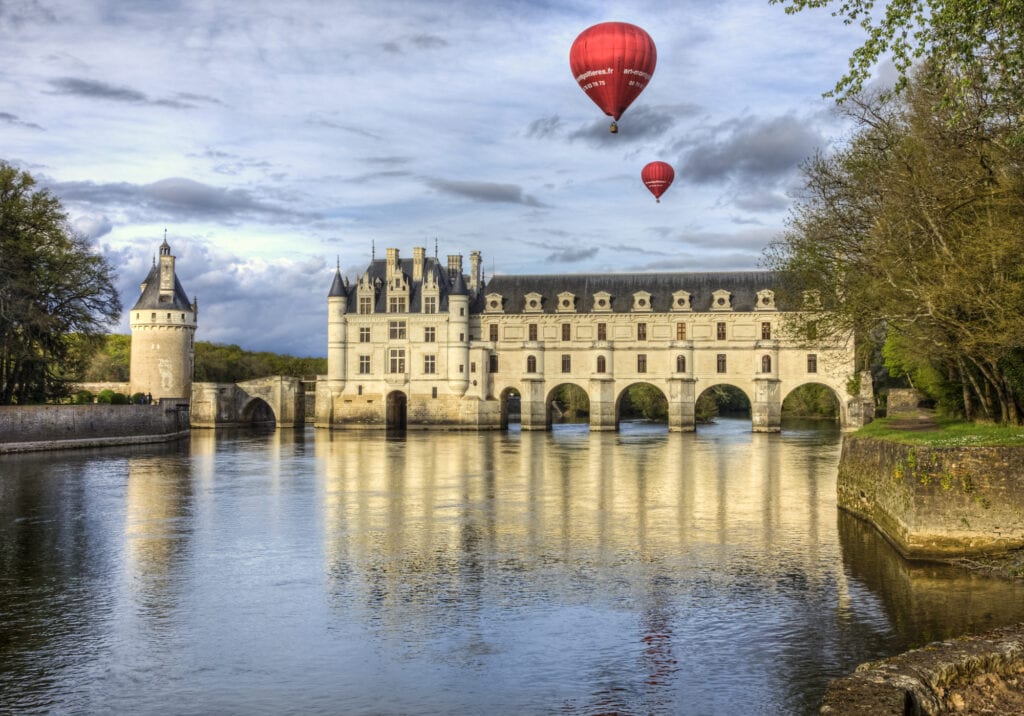
After King Henri II died, his jealous wife Catherine forced Diane to relinquish Chenonceau and exchange her beautiful home for the Chateau Chaumont. Between Blois and Amboise, the castle of Chaumont-sur-Loire was a beautiful Chateau but Diane hated it and the only work she had done to the place was to fix her emblems on the battlements.
Catherine de Medici at Château de Chenonceau
Catherine had a gallery built above the bridge Diane had built to outdo her rival. The Gallery was designed as a two-story Italianate ballroom that took 8 years to build. Catherine also built the stables known as the Bâtiment-des-Dômes.
The Château Chenonceau quickly became Catherine’s favourite residence and it was here that her son Francis II and Mary, Queen of Scots, were married in 1560. Chenonceau was also where Catherine arranged the marriage of her daughter Margaret of Valois to marry Henri de Bourbon who eventually became the King of France – King Henry IV.
Samuel Champlain who established the French settlement of Quebec served King Henry IV during the religious wars in Brittany.
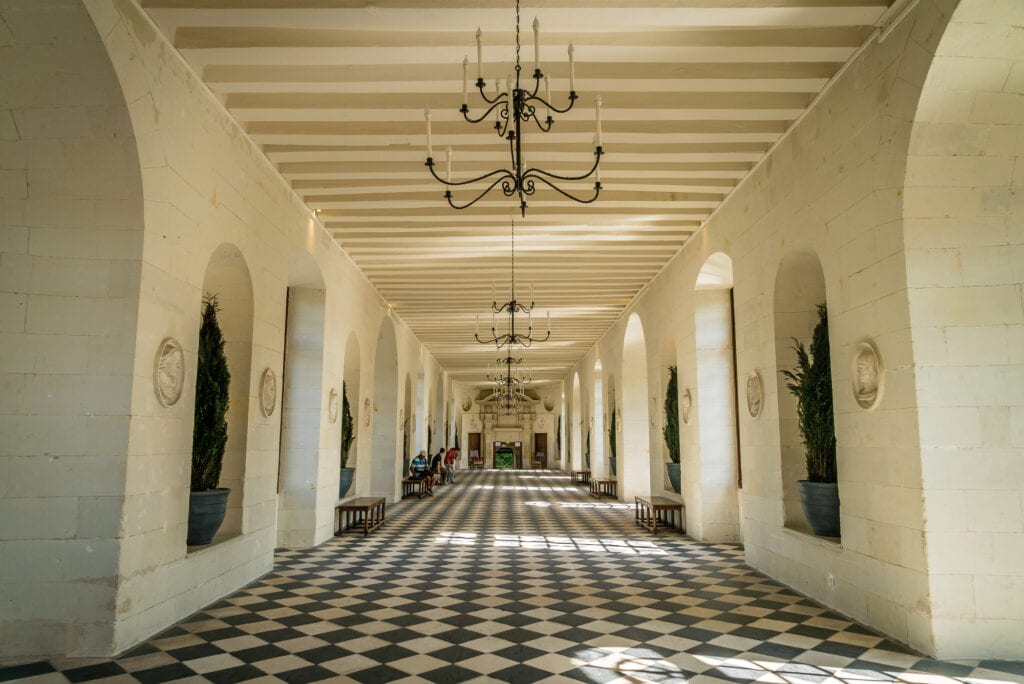
Louise de Lorraine – Henri III’s wife
Louise de Lorraine was the next woman to inherit the Chateau. Louise had married Catherine’s son Henri III but sadly he was assassinated in 1589 and Louise moved to the Chateau, where she remained in mourning until the day she died.
Louise Dupin
The next woman to live at Chenonceau was Madame Dupin in 1733 the estate was sold to her husband Claude Dupinan. Louise was an early feminist who fought for women to get an education and wrote a book titled On the Equality of Men and Women. Louise turned the Chateau is a grand salon where she could entertain and learn from the day’s greatest poets, scientists, writers and philosophers. Rousseau and Voltaire along with writers and poets such as Montesquieu and Fontenelle, and scientists such as Buffon.
It was Louise who saved the chateau during the French revolution and it was she who removed the x on Chateau. Louise died in 1799 and you can see her grave on the left bank of the Cher river in the forest.
Marguerite Pelouze
Marguerite Pelouze and her husband bought the Chateau from the Bourbons and spent the next 10 years restoring the castle and getting rid of many of Catherine de Medici’s changes. Marguerite wanted to bring the Chateau back to its 16th-century appearance. However, in 1888 she had to sell the Chateau as she could not afford the cost and was facing bankruptcy and the chateau had to be sold.
By the seventeenth century, the centre of power in France has shifted away from the Loire and Chenonceau was increasingly abandoned and much of the art and valuable furnishings were sold off.
Chateau Chenonceau 20th century
José-Emilio Terry, a Cuban millionaire, acquired Chenonceau castle from Madame Pelouze in 1891. Terry sold it in 1896 to a family member, Francisco Terry who then in 1913, sold the château to Henri Menier, a member of the Menier family, famous for their chocolates, who still own it to this day.
The Meniers restored and maintained the Castle and during World War I and the gallery was used as a hospital. The second WW saw the château bombed by the Germans in June 1940 and in that same year the Cher River flooded and destroyed the gardens at the Chateau.
The Chateau de Chenonceau was used as a means of escaping from the Nazi-occupied zone for Jews and other refugees fleeing from the German-occupied zone (north of the Cher) to the Vichy-controlled zone (south of the river). Eventually, the Chateau was occupied by the Germans and was bombed by the Allies on 7 June 1944, when the chapel was hit and its windows destroyed.
In the very early 50’s the Menier family brought in Bernard Voisin to restore the château and it was he who brought the Chateau and its gardens back to their former glory.
What to see at the Chateau Chenonceau
Nowadays, Laure Menier heads the privately owned estate and it is open to visitors year-round. A year-long calendar of events—concerts, garden parties, flower workshops, wine tastings, and night walks—allows latter-day visitors a taste of life in de’ Medici’s time.
Château de Chenonceau facts
How many rooms are in the Château de Chenonceau? There are 20 rooms at the Chateau de Chenonceau that can be visited.
What is the main feature of the Chateau Chenonceau? The expanse of the Château that spans the River Cher constitutes the great gallery/hall, used as a ballroom. It is 60 meters by 6 meters (approximately 197 feet by 20 feet) and has 18 windows.
Chateau de Chenonceau inside
The interior of the Château de Chenonceau is filled with impressive tapestries, fine furnishings, fireplaces, and decorative highlights. You will see many fine rooms such as the chapel, the main ‘salon’, the royal chambers, the galleries and the library, all furnished as they were in centuries gone by.
Chenonceau possesses an exceptional museum collection of paintings by great masters: Murillo, Tintoretto, Nicolas Poussin, Correggio, Rubens, Primaticcio, Van Loo, and a rare selection of Flemish tapestries of the XVI century.
Ground Floor of Château de Chenonceau
The Marques Tower is separate from the main Renaissance palace and it is a medieval keep. See if you can spot the salamander and inscription in memory of King Francis I, who confiscated the chateau in 1535 for the crown as part of a debt settlement.
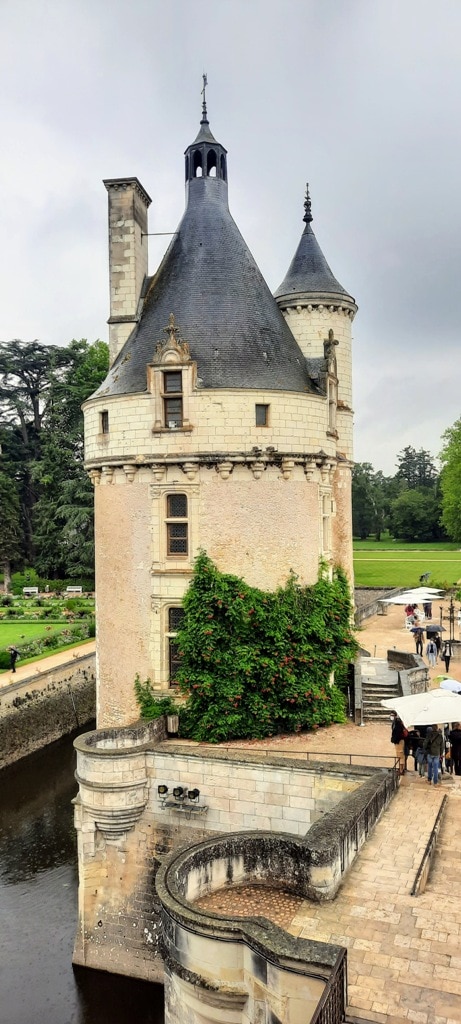
The salamander represents his confidence in God and corresponded to chastity, loyalty and virginity. The salamander was a powerful symbol because it was associated with both fire and poison and many people were afraid of it. Even brilliant minds like Leonardo da Vinci believed this because he wrote about the salamander: “This has no digestive organs, and gets no food but from the fire, in which it constantly renews its scaly skin. The salamander, which renews its scaly skin in the fire,—for virtue.
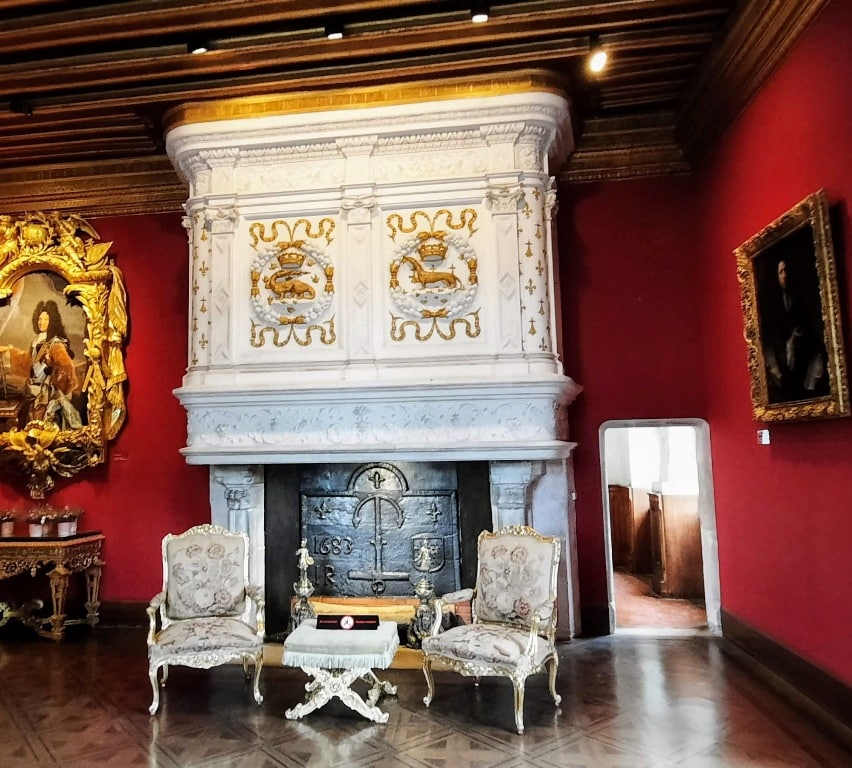
In the guards’ room, you will see the intertwined Cs of Catherine de Medici as well as sixteenth-century tapestries. The chapel has modern stained-glass windows but the English graffiti was done by the bodyguards of Mary Queen of Scots, who stayed here in the 1540s.
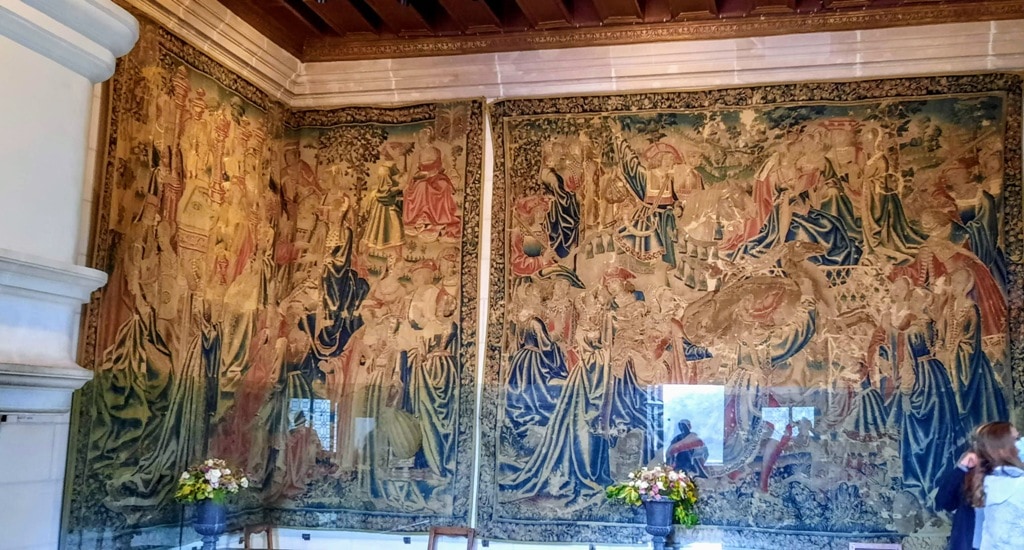
The Chapel at Chenonceau is simply breathtaking. Sadly the original stained glass windows were destroyed by bombs during WWII but the ‘new’ glass was designed and created in 1954 by the Master Glassworker, Max Ingrand.
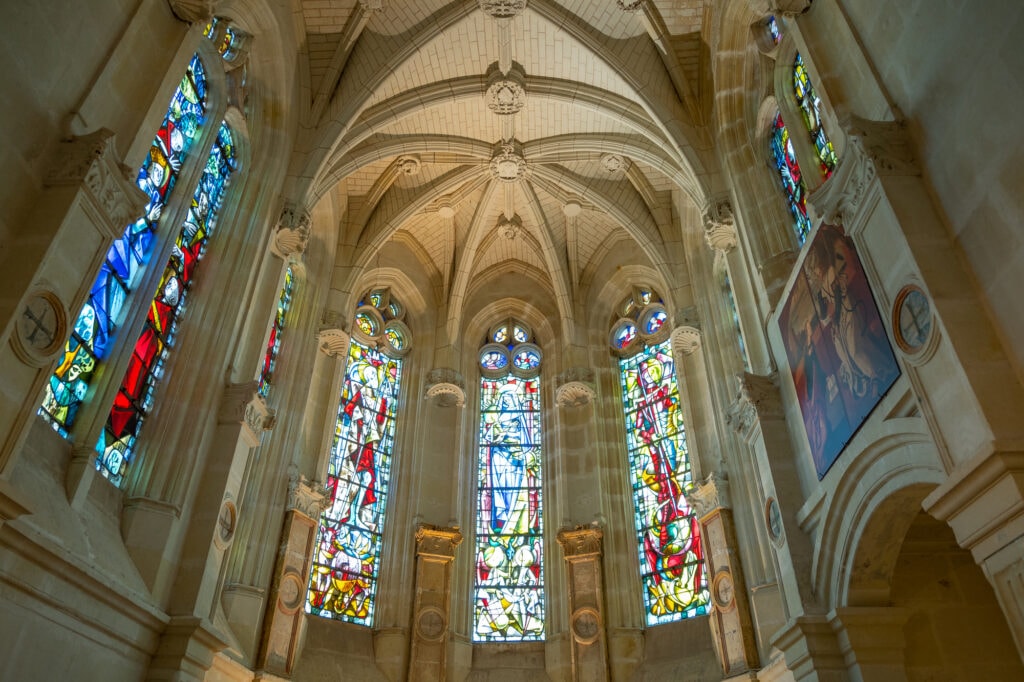
In the bedroom of Diane, Catherine had her double C and her husband’s H engraved on the fireplace and coffered ceiling. However, the C&H combined look like D for Diane. Catherine did not sleep here – she had a bedroom on the second floor.
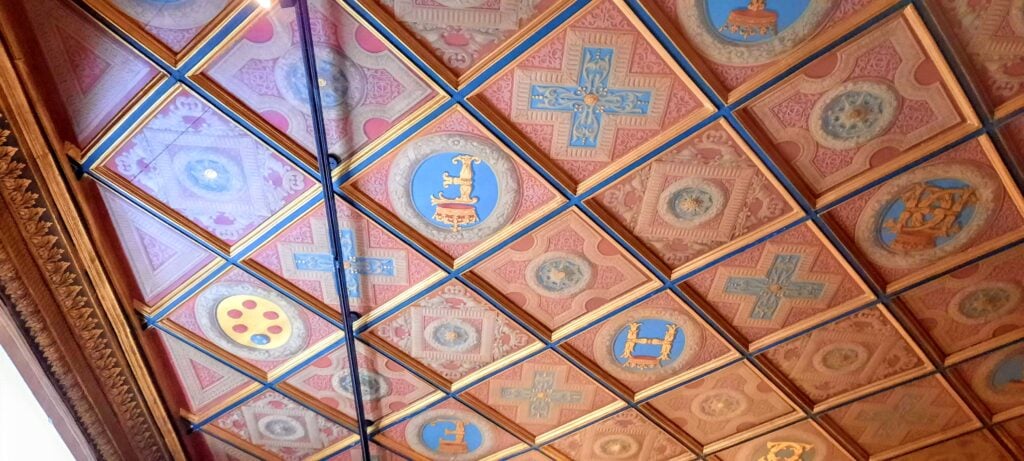
The green study is where Catherine de Medici ruled France as regent and the paintings include those of Tintoretto, Jordaens, Veronese, Poussin, and Van Dyck. There are also many old masters in the small library, which offers some of the finest views from the chateau.
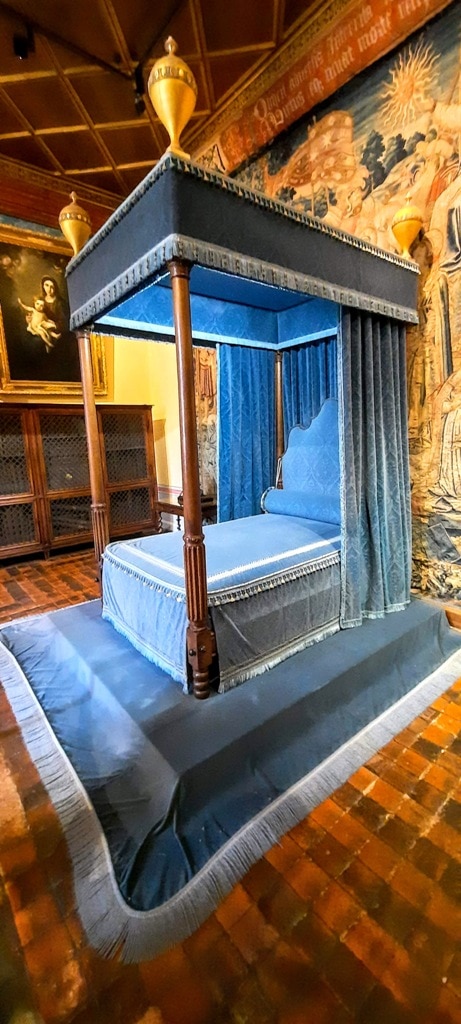
On the ground floor, you will see Francois I drawing room which is lavishly decorated with rich wallpaper, a fine Renaissance fireplace, and paintings. These include a self-portrait by Van Dyck and a painting by Van Loo featuring three mistresses of Louis XV.
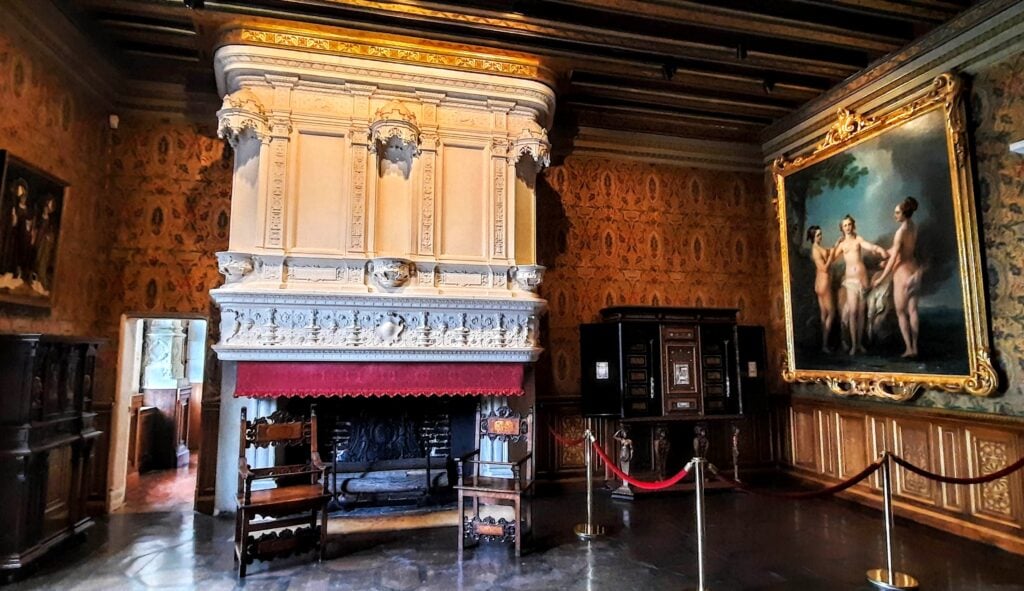
The adjacent Louis XIV drawing room features a large Rubens painting of the Sun King in a huge gilded frame. Louis XIV actually visited Château de Chenonceau (on 14 July 1650). The Rubens once belonged to Joseph Bonaparte.
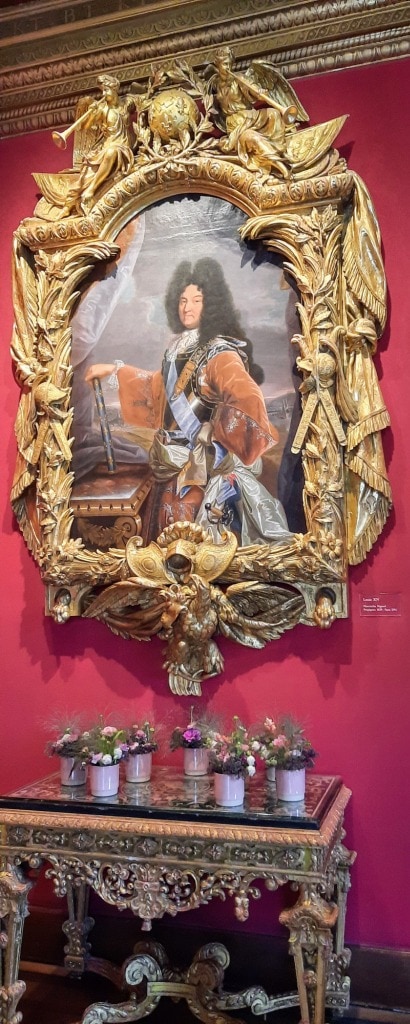
The Gallery of Château de Chenonceau
A narrow passage leads to the gallery which Catherine had built on top of Diane’s bridge. The gallery is lit by 18 large windows and it was a famous party room during Catherine’s time at Chenonceau. You will spot several empty niches that used to contain statues that were sold to Louis XIV and are found at Versailles.
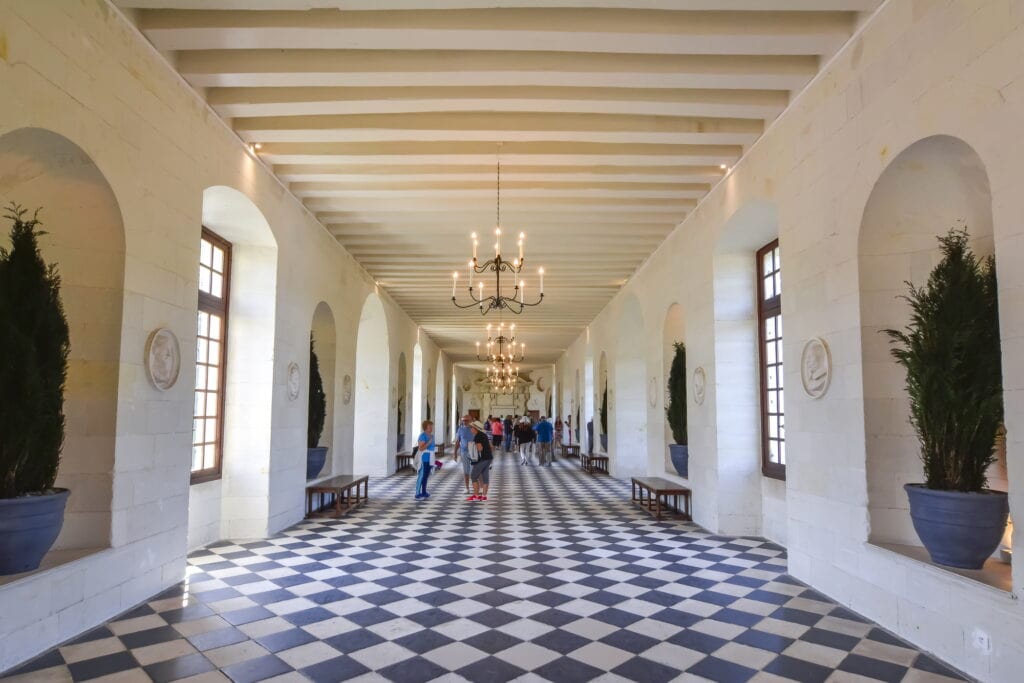
Visitors can usually exit the chateau at the opposite end for some of the finest views of the chateau and gallery. Don’t lose the token for readmission or it is a very long walk back to the main entrance.
The Kitchens of Chenonceau
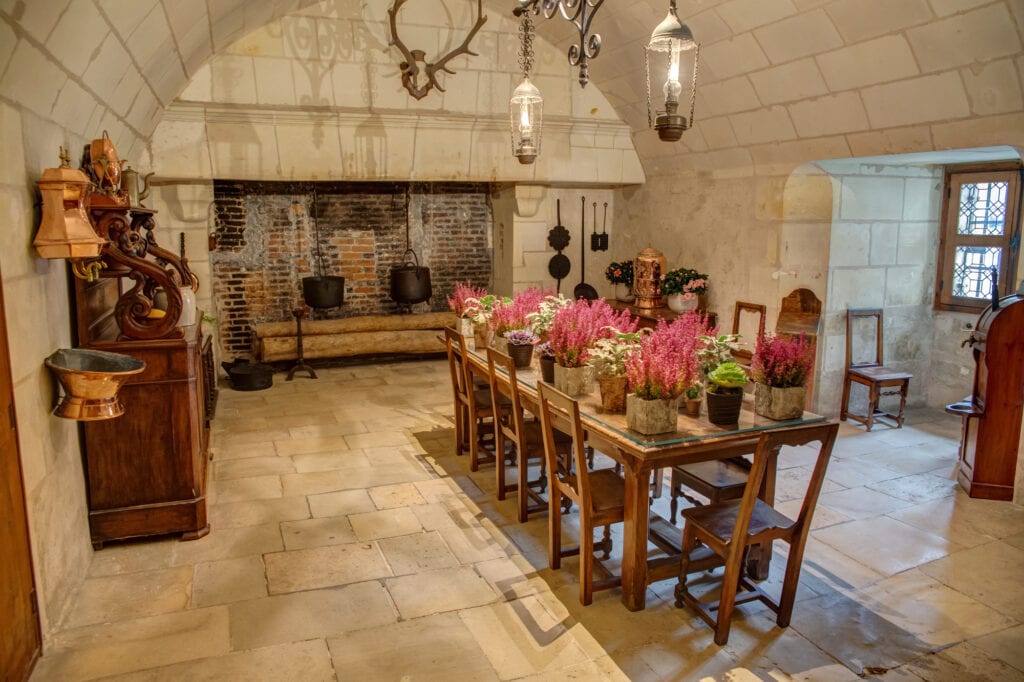
The kitchens are found in the large basement a set of narrow stairs leads down to the kitchen, pantry, and other rooms used by staff. The kitchen equipment dates mostly to the First World War period.
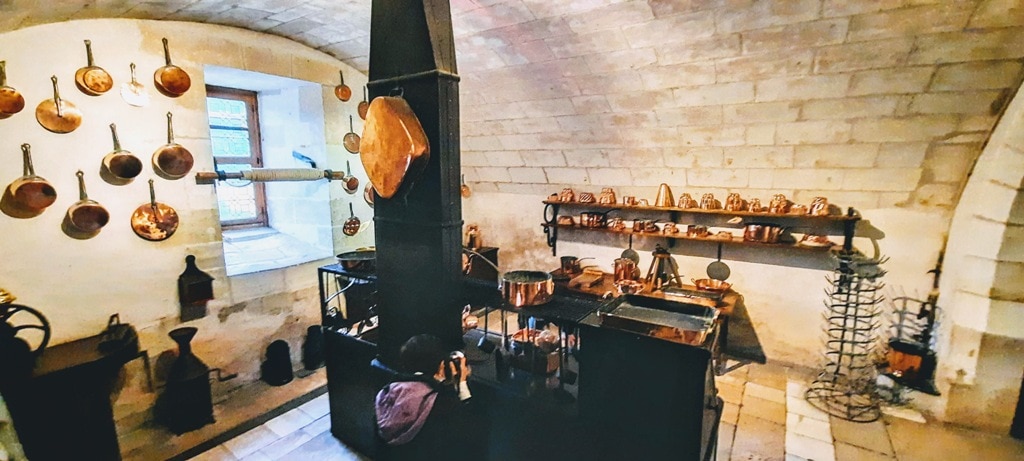
The Upper Floors at Château de Chenonceau
The staircase leading to the upper floor is considered to be the first Italian straight staircase to have been built in France and it was commissioned by Katherine Briconnet (Bohier) The Hall is decorated with 17th-century tapestries as well as marble medallions of Roman emperors that Catherine de Medici brought over from Italy.
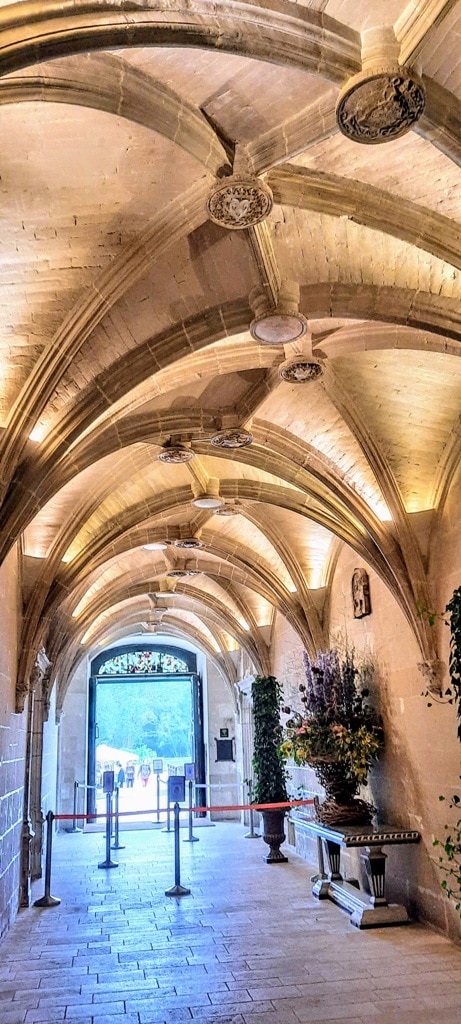
The lavishly decorated Five Queens’ Bedroom features 16th-century Flemish tapestries and a small Rubens. It is called the Five Queens Bedroom because (obviously) 5 Queens used it. Catherine de Medici’s two daughters – Queen Margot (wife of Henri IV) and Elisabeth of France (wife of Philippe II of Spain), and her three daughters-in-law: Mary Stuart (wife of Francois II and Queen of Scots), Elisabeth of Austria (wife of Charles IX) and Louise of Lorraine (wife of Henri III).
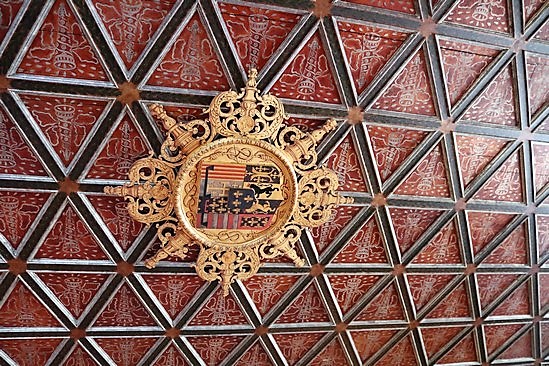
Catherine de Medici’s bedroom had views of the River Cher and the gallery. Two further sumptuous bedrooms on this floor belonged to Gabrielle d’Estrées and her son Cesar of Vendôme – the son of Henri IV and uncle of Louis XIV. Both rooms have extravagant tapestries and period furniture.
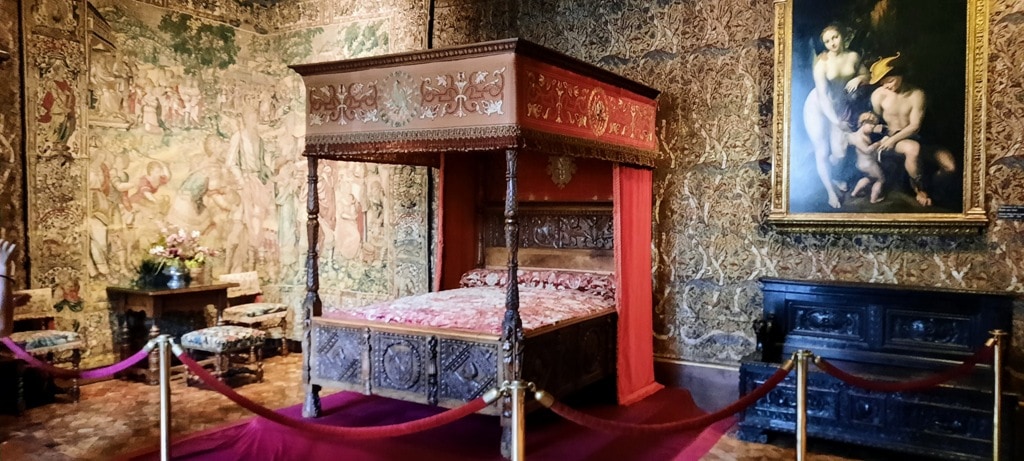
On the top floor are a less lavish hall and the bedroom of Louise of Lorraine. At that period in time, France was torn apart by the wars between the Catholics and Protestants. Henri Louise’s husband was assassinated by the monk Jacques Clément in 1589. He was 37 years old. Louise spent her remaining years mourning Henri at Chenonceau.
Château de Chenonceau was bequeathed to her by Catherine de Medici. Louise surrounded herself with nuns and essentially transformed Chenonceau into a convent. She remained there until her death in 1601 at the age of 47.
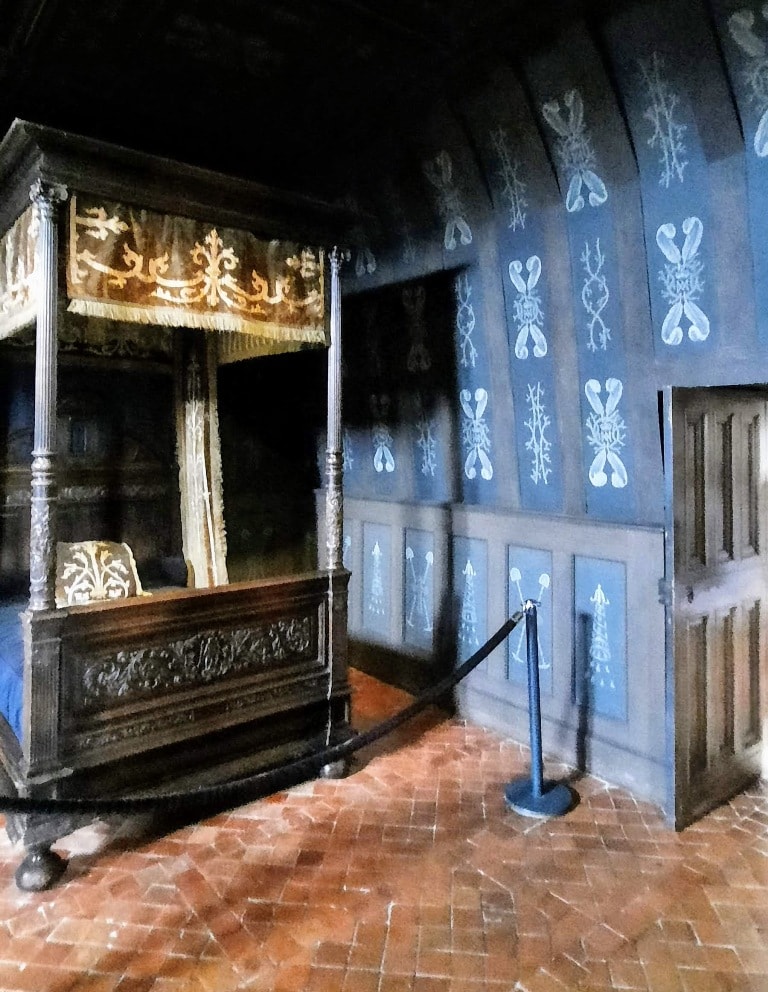
The black room reflects her mourning and is decorated with crosses, spades, burial picks, and cornucopias spilling tears and the bed and window drapes are decorated in black and silver and the room is hung with black tapestries.
When Louise de Lorraine died, the castle, covered with debts, passed to her niece and all her property was distributed to pay her debts.
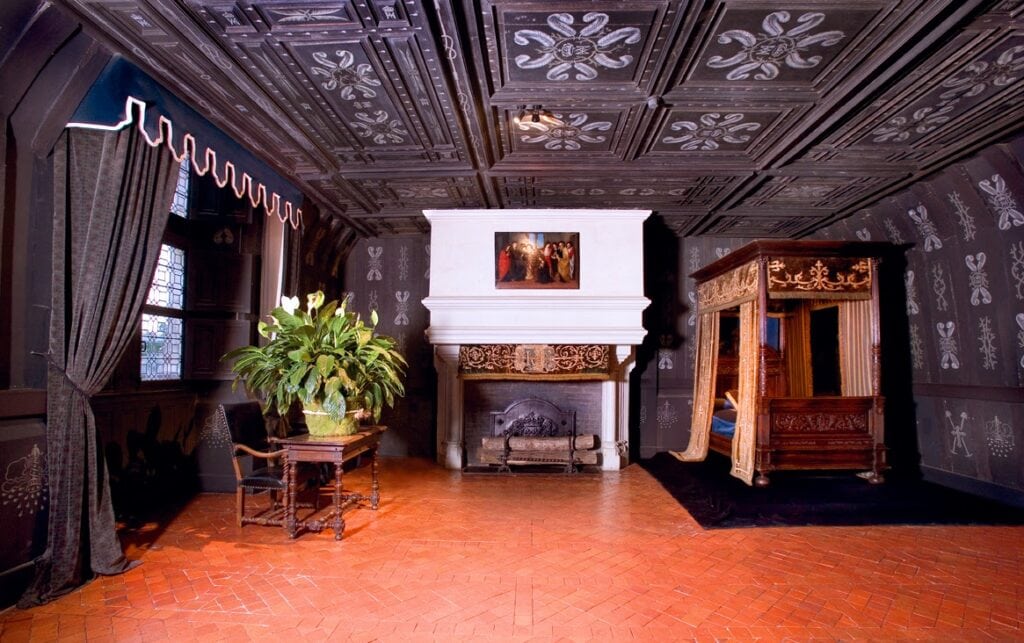
Gardens of the Chateau de Chenonceau
After exploring the castle you can wander through the gardens. The gardens of Diane de Poitiers and Catherine de Medici are the most impressive formal gardens, there is also a woodland area containing a maze and statues
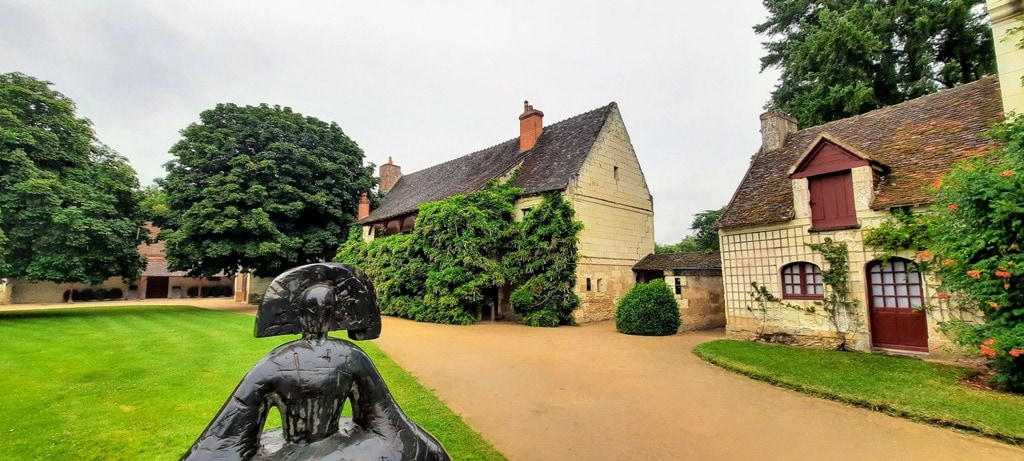
On the grounds, you will find a gorgeous 16th-century farmhouse, a Carriage Gallery and Catherine de Medici’s stables. In the stables of the farm, ten French and English horse-drawn carriages are displayed. There is a pond just outside that is home to some rare ducks and swans. You can also spot a sheltered garage of sorts that is home to two old Bentley automobiles.
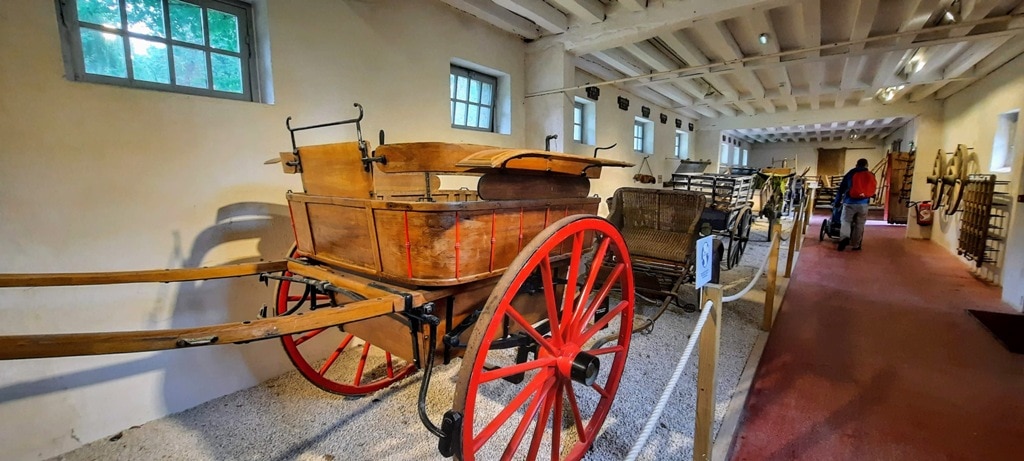
Beyond these are the vegetable and flower gardens. The flowers are used to decorate the Chateau giving it a wonderful lived-in air. These flower gardens include banks of Lavender that perfume the air with a scent that stays with you for hours.
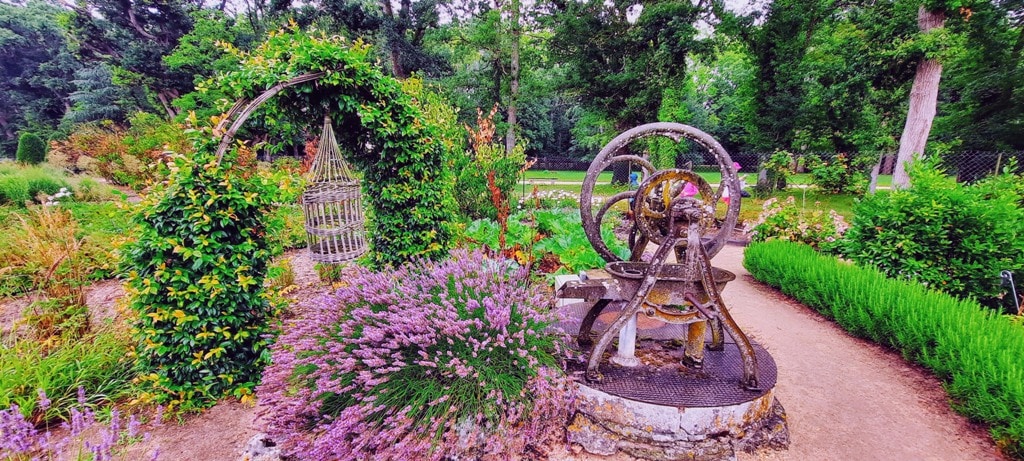
There is also a Donkey paddock that contains 6 lovely friendly donkeys and for the children a new Musical Garden with drum turrets and xylophone, animals to play with…
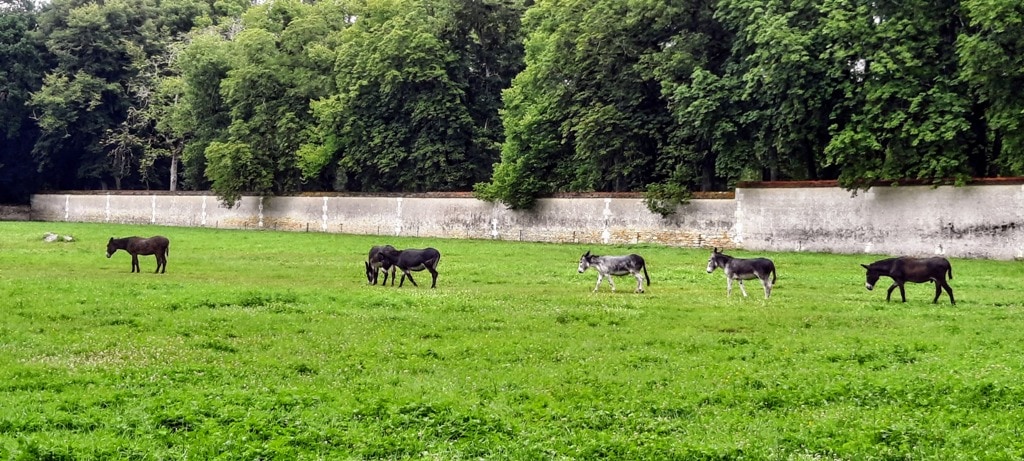
Diane de Poitiers Garden
The centrepiece of Diane de Poitiers’s garden is the floating parterre whose structure remains unchanged but with a changed layout. These geometrical gardens have remained unchanged since their creation by Diane de Poitiers. They are composed of two perpendicular and diagonal alleys that frame the flowerbeds. The garden is protected from floods by elevated terraces that go all around.
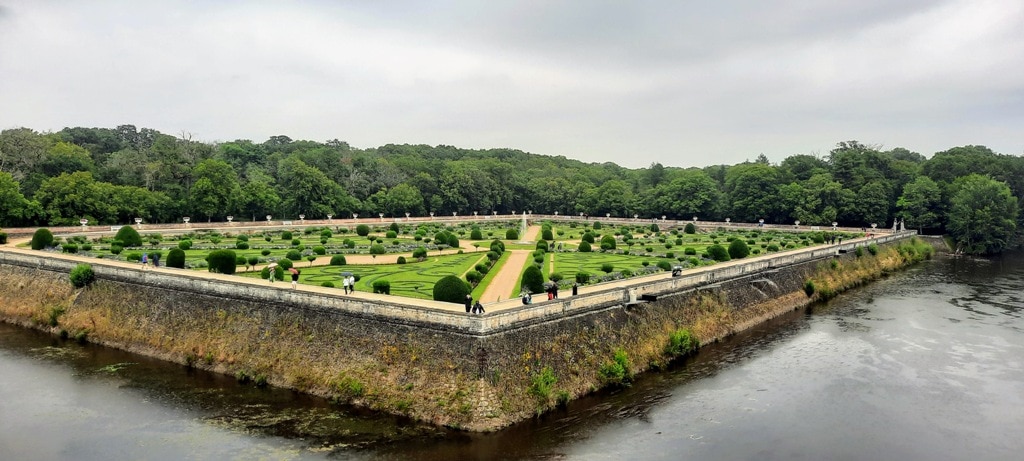
Catherine de Medici Garden
The Catherine de Medici gardens revolve around a large round pond and 5 lawns bordered by flowerbeds. There is also a Green garden designed in 1825, an English-style park surrounded by large trees. An Italian maze opens onto a view of Goujon’s massive Caryatids that once decorated the front of the Chateau.
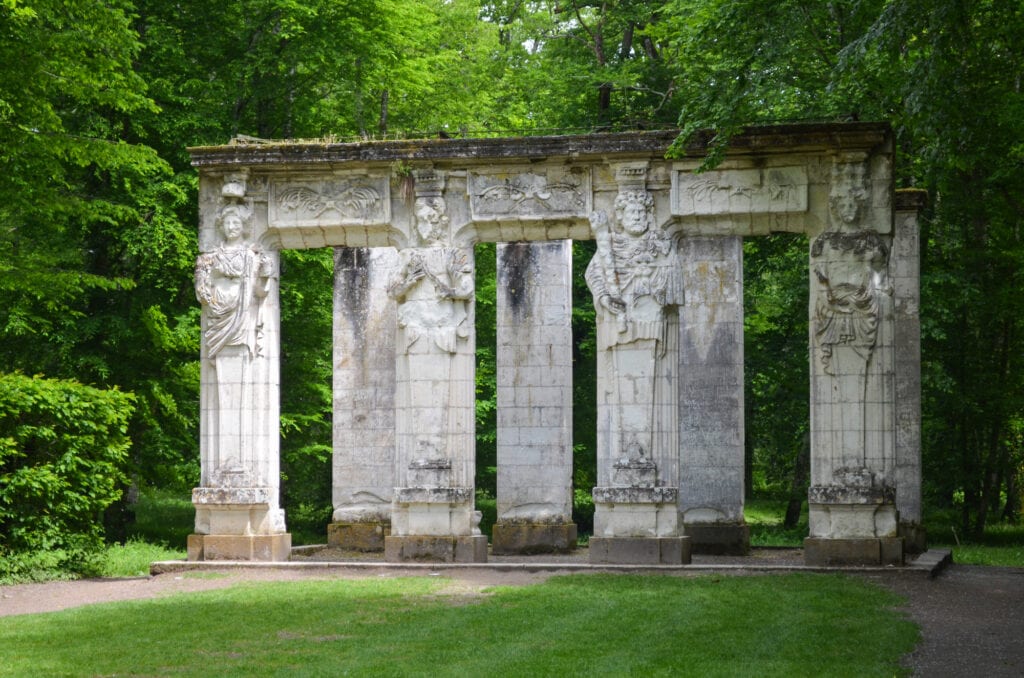
The Queen’s Apothecary
From a young age, Catherine de Medici was surrounded by scholars and herbalists. When she lived in the Château of Chenonceau, the queen possessed her own apothecary’s laboratory where the famous Nostradamus prepared remedies and concoctions for her.
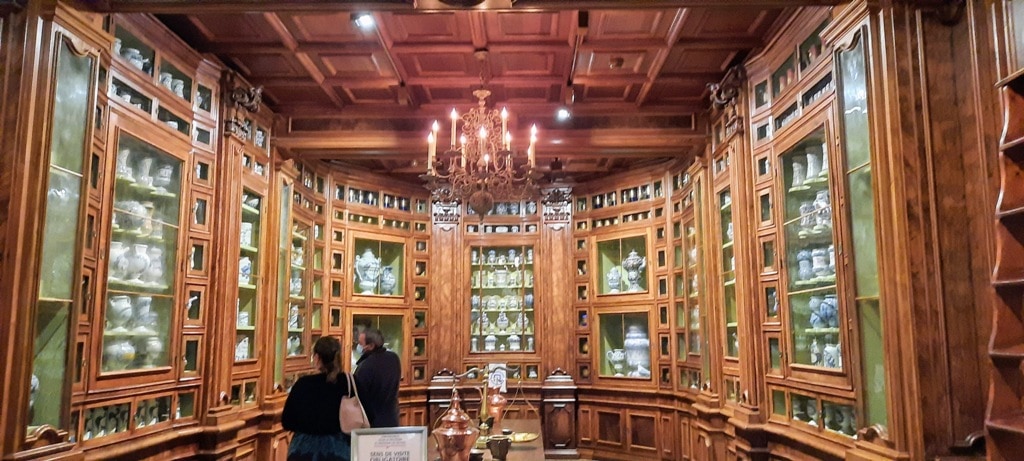
In the building known as “Les Dômes”, the Château has reconstructed the dispensary from scratch, as it was in the 16th century. Its glass and wood cases, originally from a Florentine palace, house a collection of 500 flasks, scales, mortars and earthenware pots, some of which date back to the 14th century.
WWI and WWII at Chenonceau
There is a reconstructed tableau of what the grand gallery would have looked like when it was converted into a hospital for the veterans and survivors of WWI. There was a 120-bed ward and a surgical facility set up in Catherine de Medici’s two galleries. The Menier family paid all of the expenses, treating 2,254 soldiers before the war ended. Simone Menier, who was the chief nurse, ran the hospital with her husband, George.
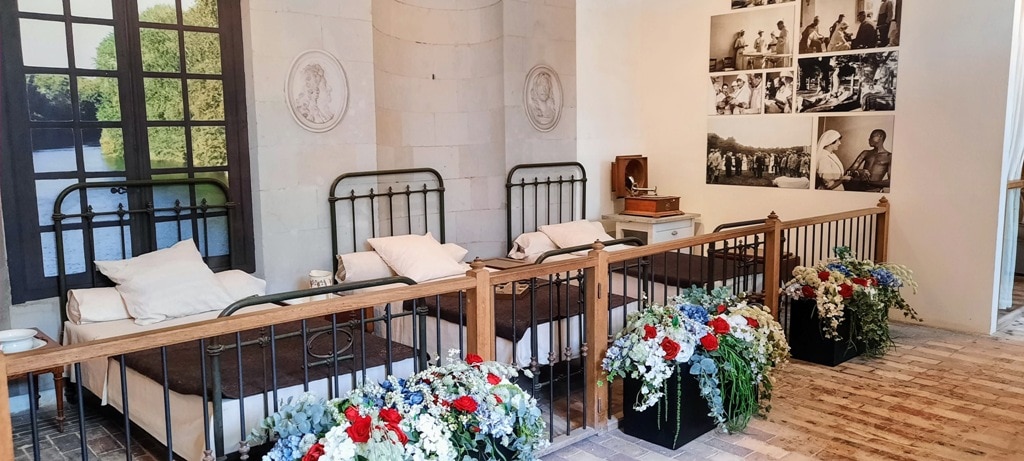
Chenonceau bridges the Cher river, which was the demarcation line between occupied and free France between July 1940 and November 1942. During this period, France was effectively separated into two parts, one occupied by the Nazis including the cities of Paris, Lille, Nantes, and Bordeaux, and the other called “free” whose government based in Vichy and became the Vichy Government that collaborated with the Nazi’s.
During the Second World War, the Grand Gallery at Chenonceau became the sole point of access to the free zone, and the Menier family helped to smuggle out people fleeing Nazi tyranny. Although German guards patrolled the river, Simone Meunier unlocked the doors to the gallery whenever the patrols were out of sight, helping hundreds of Jews and French villagers to escape. The US president, Harry Truman, visited the château on his first trip to France.
Where to eat at Chenonceau
The gourmet restaurant l’Orangerie is located in the Green Garden of the Chenonceau chateau. This first-class restaurant allows you to enjoy a lunch, with fresh produce from the gardens and a remarkable view of the castle. Sadly at this time, the Orangerie restaurant is still closed.
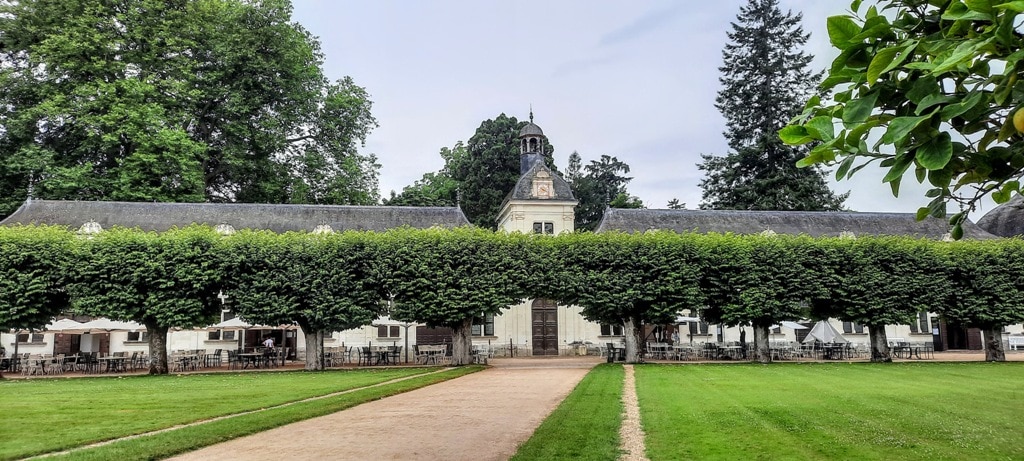
As you walk to the Chateau you will spot to your right The Summer Snack bar a self-service restaurant which offers a wide choice of hot dishes, sandwiches, desserts, and cold drinks.
There are lovely Picnic areas allocated within the grounds along the moat and at the entrance to the castle where you can bring your own food and drink to enjoy.
There is also a boutique shop at the entrance to the Chateau where you can pick up some souvenirs from your visit.
Château de Chenonceau wine
The château’s historic wine cellar welcomes visitors for wine tastings under its superb 16th-century vaulted ceiling. AOC Touraine Chenonceaux white and red, rosé from the Touraine Appellation, Méthode Traditionnelle sparkling white and rosé wine Our wines are sold on-site, in cases of one or three bottles. We also sell many other products and items relating to the world of wine.
Where to stay near Chenonceau
Gite Les Coquelicots
Featuring a garden with an outdoor swimming pool, Gite Les Coquelicots is located 3 km from Chenonceaux Castle and 26 km from Beauval Zoo. With free private parking and free WiFi, it is the starting point of several hiking paths. With a view of the countryside and the vineyards, this self-catering cottage has a fully equipped kitchen with dishwasher, electric kettle and coffee machine. Oil, butter, eggs, tea, coffee, sugar and pasta are provided upon arrival. Loches and Chaumont Castles are 25 km away while Amboise Castle is 16 km away. The train station is 3 km from Gite Les Coquelicots.
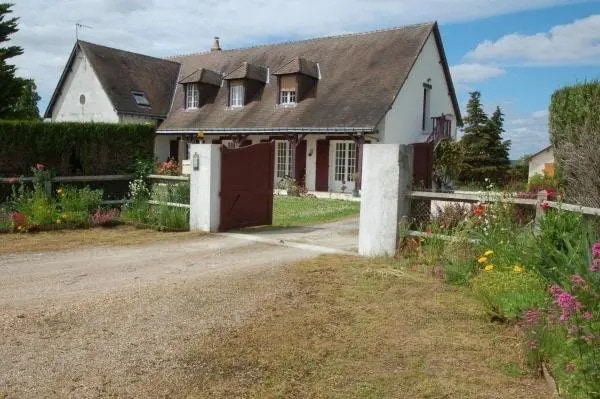
Le Moulin de Francueil
Offering city views, Le Moulin de Francueil in Francueil offers accommodation, a seasonal outdoor swimming pool, a garden, a shared lounge and a terrace. The bed and breakfast features both WiFi and private parking free of charge. A continental breakfast is available every morning at Le Moulin de Francueil. Guests at the accommodation can enjoy darts on site, or cycling in the surroundings. Château de Chenonceau is 3.4 km from Le Moulin de Francueil, while Chateau de Montpoupon is 13 km from the property.
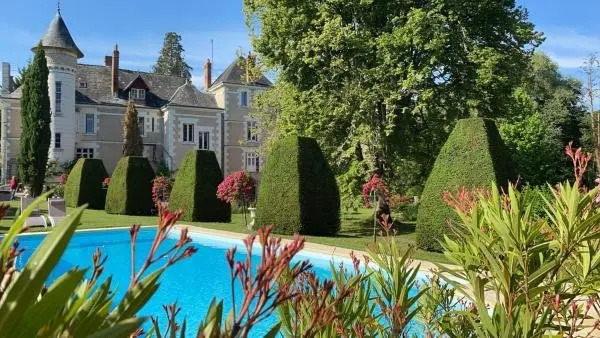
Today’s Chateau de Chenonceau harks back to a more chaotic but romantic time in French history without forgetting the trials of the centuries. It is aptly named the Ladies Chateau for its beautifully orchestrated interiors and gardens where you can almost imagine walking with royalty. Definitely my favourite of all the Chateaux in the region.
FAQS about the Chateau de Chenonceau
Frequently Asked Questions about the Château de Chenonceau
1. What is the Château de Chenonceau?
The Château de Chenonceau is a renowned castle located in the Loire Valley in France. It is also known as the Chateau de Chenonceaux and spans the River Cher.
2. Who were Catherine de Medici and Diane de Poitiers in relation to the Château de Chenonceau?
Catherine de Medici and Diane de Poitiers were two influential women associated with the Château de Chenonceau. Catherine was the wife of King Henry II and Diane was his mistress.
3. What makes the Château de Chenonceau unique?
The Château de Chenonceau is known for its beautiful architecture, exquisite gardens, and its location spanning the River Cher, giving it a unique and picturesque setting.
4. Is the Château de Chenonceau open to the public?
Yes, the Château de Chenonceau is open to visitors who wish to explore its history, architecture, and gardens. It is one of the most popular châteaux in France.
5. When was the Château de Chenonceau built?
The construction of the Château de Chenonceau began in the 16th century and has undergone several renovations and expansions over the years.
6. What role did the Château de Chenonceau play in history?
The Château de Chenonceau has played various roles throughout history, including serving as a residence for royalty, a hospital during World War I, and a means of escape during World War II.
You can take a Chateau de Chenonceau virtual tour here.
Here are some more articles on France that you may find interesting
Pros and Cons of Living in France
Cancale the charming oyster capital of France
Visiting Fougères France – City of Art and History
Sainte Suzanne Mayenne France A Charming Medieval Village
Food in Brittany: Fall in love with the food of Bretagne
One fabulous day in Menton France
Chinon France: A Royal Fortress and a medieval city
Exploring the Charms of Vitré, France: Things to do in Vitre
An Itinerary for Paris – How to create the perfect one
French Cheese – 23 amazing types of French cheese
Pin it to save it
